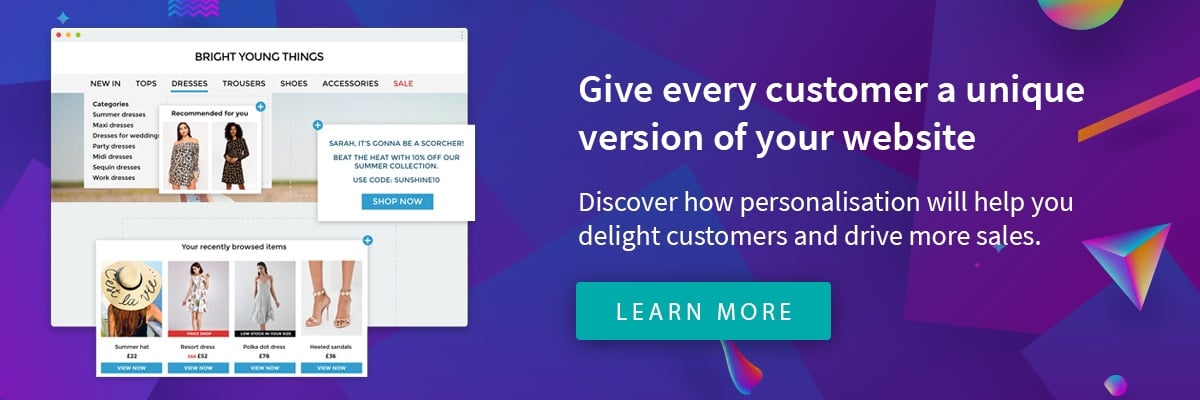Personalisation isn’t new. In fact, it’s been around for years. Is it time the tactics we use to implement it evolved?
When it comes to the theory, we all know the drill. Building highly personalised experiences is your best hope of increasing engagement and driving conversions.
We look to the likes of Amazon and marvel at the AI that drives their recommendation engine. We nod and agree that the brand’s market-leading approach to personalisation has paved its way to success.
But when it comes to implementing personalisation for our own brands, how much of this do we recreate? Do we build personalised experiences like they do? Or do we stick in a first name and hope for the best?
The reality is that many brands merely pay lip service to personalisation. They may add the odd personal touch, but they fail to implement personalisation in a meaningful way.
We recently conducted our own research to find out how consumer respond to common personalisation tactics that have been long employed in marketing. The findings have revealed the consequences of this lag between personalisation theory and practice. Read on to find out how results have been affected.
Marketers need to look beyond basic personalisation
Our research uncovered a staggering 92 percent of consumers are not likely to engage with marketing that addresses them by name.
Wishing consumers happy birthday is even less engaging. 93 percent of consumers are unlikely to engage with marketing that mentions their birthday.
Consumers have spoken and their message is clear: basic personalisation is boring. Using basic demographic information will not make your message stand out in the inbox.
So, is it curtains for the personalisation trend? Far from it. Our research revealed that almost half of consumers would be likely to engage more with retailers that send offers that are relevant and interesting to them.
Consumers are demanding value from personalisation
In an era where simple demographic personalisation no longer cuts the mustard, how can marketers compete? It’s time to get smarter about how we personalise.
In the current data climate, this prospect may ring alarm bells. Doesn’t intelligent personalisation require a tonne of data? Isn’t it intrusive?
Marketers are all too conscious of an increasing data awareness among consumers. The General Data Protection Regulation (GDPR) come into force this year and the Cambridge Analytica data scandal is still raising eyebrows.
But none of this means consumers actively dislike personalisation. YouGov reports that consumers don’t mind their data being used to personalise, so long as that personalisation helps them.
This means offering consumers value in return for their data. We must use the data we have on them to enhance their experience. To make their lives easier.
But how? One answer is behavioural marketing.
The era of behavioural marketing
Behavioural marketing is personalisation based on how consumers behave online. It uses automation to respond to specific actions with contextually relevant messages.
Behavioural marketers use automation technology to personalise email and website content based on pre-determined behaviours. For example, sending a browse abandonment email to remind a customer about a product they looked at earlier, enticing them back to buy.
This intelligent form of personalisation does more than just react. It helps to predict and shape consumer behaviour.
Hyper relevant, timely messages are your best opportunity to influence what a customer does next. Drive them to convert. Encourage them to buy again. Entice them to bump up their order value.
These tactics enhance customer journeys and improve overall customer experience. Increased revenue is a natural consequence.
Your brand is ready for this
Behavioural marketing sounds glorious, right? But is your brand ready?
Despite the availability of inexpensive intelligent personalisation tools, many brands are slow to adopt them. The potential gains from behavioural marketing remain unreached.
A major reason for this is lack of confidence. Decision makers compare their brand to Amazon and figure they can’t compete. They can’t possibly be ready for the tactics the big players use.
It’s this misconception that is holding brands back. It’s preventing them from offering consumers the experiences they deserve (and reaping the financial rewards).
Intelligent personalisation is within your reach
Consumers are demanding value from personalisation. And the tools you need to give it to them are within your reach.
The personalisation technology that powers the behavioural marketing tactics we’ve explored are out there. And they don’t cost a bomb.
What’s more, they’re easy to implement. Our personalisation platform integrate on the frontend, with one simple line of code. This enables you to get intelligent personalisation off the ground easily.
Before you know it, you’ll be using the personalisation tactics that made Amazon famous without breaking a sweat. So long as you stay focused on the goal of improving customer experience, increased revenue will follow.
The rewards of intelligent personalisation are within your reach. To get one step closer, see our platform in action by booking a demo.

